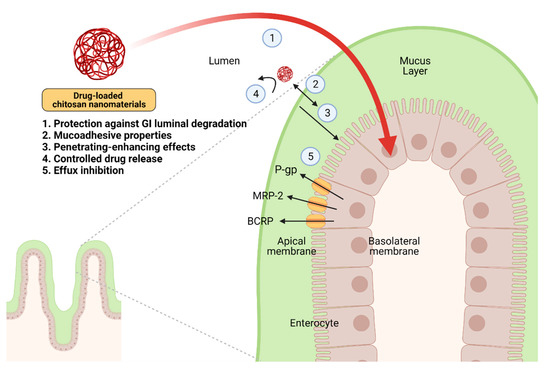
| Version | Summary | Created by | Modification | Content Size | Created at | Operation |
|---|---|---|---|---|---|---|
| 1 | Nutthapoom Pathomthongtaweechai | + 819 word(s) | 819 | 2021-06-25 11:08:14 | | | |
| 2 | Lily Guo | Meta information modification | 819 | 2021-07-13 05:38:41 | | |
Video Upload Options
The small intestine provides the major site for the absorption of numerous orally administered drugs. However, before reaching to the systemic circulation to exert beneficial pharmacological activities, the oral drug delivery is hindered by poor absorption/metabolic instability of the drugs in gastrointestinal (GI) tract and the presence of the mucus layer overlying intestinal epithelium. Therefore, a polymeric drug delivery system has emerged as a robust approach to enhance oral drug bioavailability and intestinal drug absorption. Chitosan, a cationic polymer derived from chitin, and its derivatives have received remarkable attention to serve as a promising drug carrier, chiefly owing to their versatile, biocompatible, biodegradable, and non-toxic properties. Several types of chitosan-based drug delivery systems have been developed, including chemical modification, conjugates, capsules, and hybrids. They have been shown to be effective in improving intestinal assimilation of several types of drugs, e.g., antidiabetic, anticancer, antimicrobial, and anti-inflammatory drugs. In this review, the physiological challenges affecting intestinal drug absorption and the effects of chitosan on those parameters impacting on oral bioavailability are summarized. More appreciably, types of chitosan-based nanomaterials enhancing intestinal drug absorption and their mechanisms, as well as potential applications in diabetes, cancers, infections, and inflammation, are highlighted. The future perspective of chitosan applications is also discussed.
1. Introduction
2. Chitosan-Based Nanomaterials for Improving Intestinal Drug Absorption and Their Pharmacological Applications

References
- Khafagy, E.-S.; Morishita, M. Oral biodrug delivery using cell-penetrating peptide. Adv. Drug Deliv. Rev. 2012, 64, 531–539.
- Chen, M.C.; Mi, F.L.; Liao, Z.X.; Hsiao, C.W.; Sonaje, K.; Chung, M.F.; Hsu, L.W.; Sung, H.W. Recent advances in chitosan-based nanoparticles for oral delivery of macromolecules. Adv. Drug Deliv. Rev. 2013, 65, 865–879.
- Hatton, G.B.; Madla, C.M.; Rabbie, S.C.; Basit, A.W. Gut reaction: Impact of systemic diseases on gastrointestinal physiology and drug absorption. Drug Discov. Today 2019, 24, 417–427.
- Lang, X.; Wang, T.; Sun, M.; Chen, X.; Liu, Y. Advances and applications of chitosan-based nanomaterials as oral delivery carriers: A review. Int. J. Biol. Macromol. 2020, 154, 433–445.
- Patra, J.K.; Das, G.; Fraceto, L.F.; Campos, E.V.R.; Rodriguez-Torres, M.D.P.; Acosta-Torres, L.S.; Diaz-Torres, L.A.; Grillo, R.; Swamy, M.K.; Sharma, S.; et al. Nano based drug delivery systems: Recent developments and future prospects. J. Nanobiotechnol. 2018, 16, 71.
- Bajracharya, R.; Song, J.G.; Back, S.Y.; Han, H.K. Recent Advancements in Non-Invasive Formulations for Protein Drug Delivery. Comput. Struct. Biotechnol. J. 2019, 17, 1290–1308.
- Sung, Y.K.; Kim, S.W. Recent advances in polymeric drug delivery systems. Biomater. Res. 2020, 24, 12.
- Bernkop-Schnürch, A.; Dünnhaupt, S. Chitosan-based drug delivery systems. Eur. J. Pharm. Biopharm. Off. J. Arb. Pharm. Verfahr. EV 2012, 81, 463–469.
- Homayun, B.; Lin, X.; Choi, H.J. Challenges and Recent Progress in Oral Drug Delivery Systems for Biopharmaceuticals. Pharmaceutics 2019, 11, 129.
- Thadathil, N.; Velappan, S.P. Recent developments in chitosanase research and its biotechnological applications: A review. Food Chem. 2014, 150, 392–399.
- Muanprasat, C.; Chatsudthipong, V. Chitosan oligosaccharide: Biological activities and potential therapeutic applications. Pharmacol. Ther. 2017, 170, 80–97.
- Grenha, A. Chitosan nanoparticles: A survey of preparation methods. J. Drug Target. 2012, 20, 291–300.
- Hu, L.; Sun, Y.; Wu, Y. Advances in chitosan-based drug delivery vehicles. Nanoscale 2013, 5, 3103–3111.




